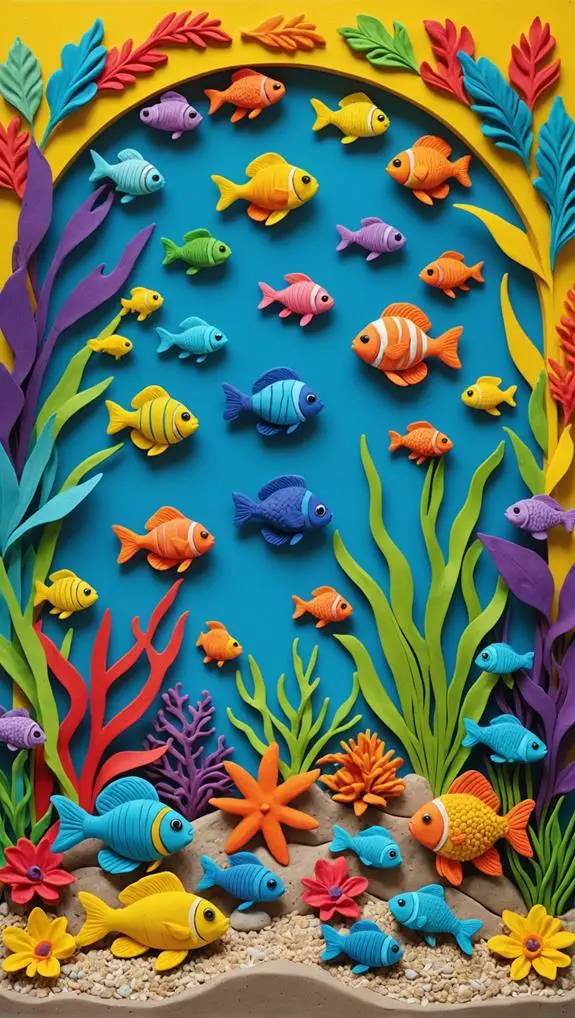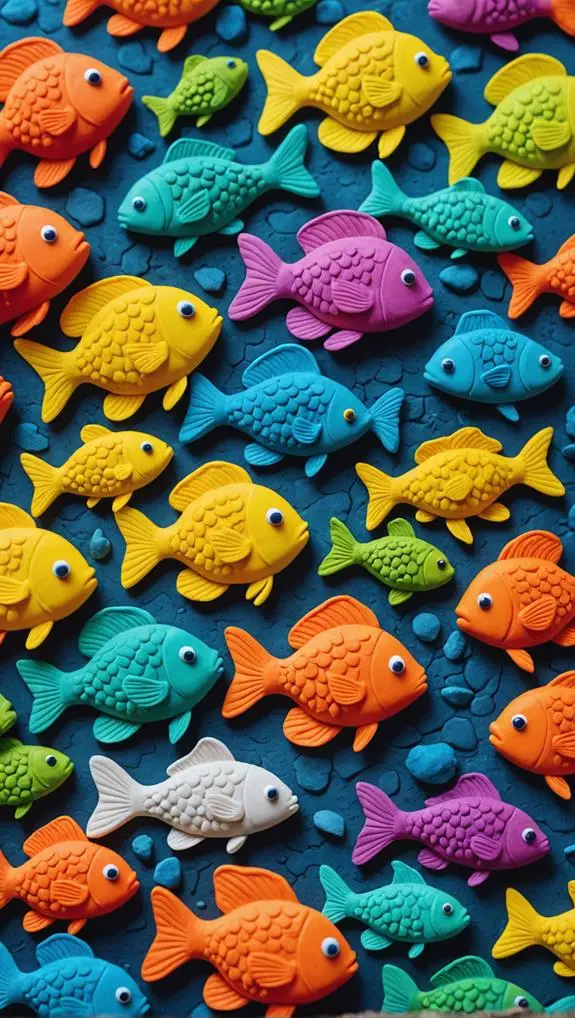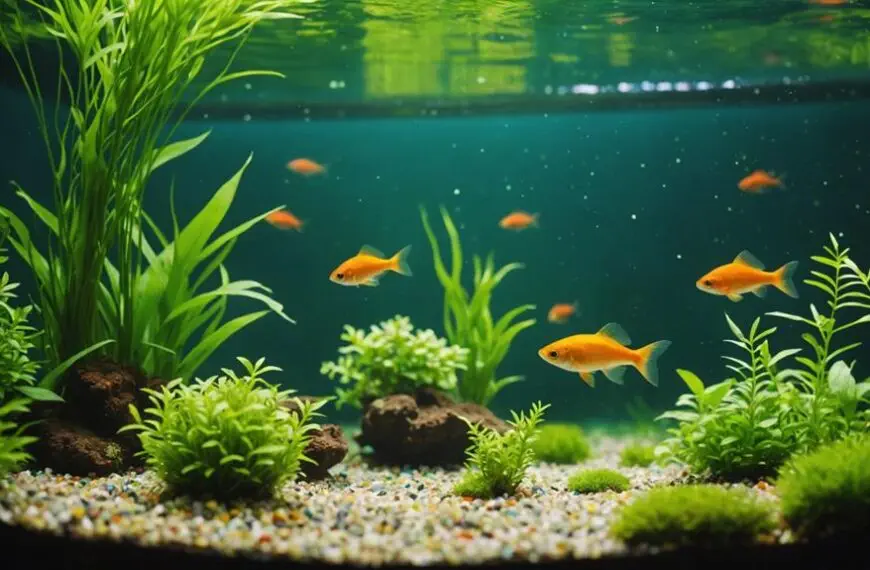Choosing the right fish flakes for your aquarium is simpler than it sounds! Start by knowing your fish's needs—are they carnivores, herbivores, or omnivores? Look for flakes that match their diet, ideally with high-quality protein as the first ingredient. Size matters too; tiny fish need small flakes, while larger ones prefer bigger bites. Keep an eye on the nutritional info—aim for around 40-50% protein for carnivores. Don't forget to vary the diet to keep your fish excited at mealtime! And if you want more helpful tips, just hang tight for the next bits of wisdom!
Contents
- 1 Understanding Fish Dietary Needs
- 2 Types of Fish Flakes
- 3 Nutritional Content Analysis
- 4 Reading Fish Food Labels
- 5 Matching Flake Size to Fish
- 6 Feeding Frequency and Practices
- 7 Evaluating Quality Fish Flakes
- 8 Common Feeding Issues
- 9 Recommended Fish Flake Brands
- 10 Frequently Asked Questions
- 11 Final Thoughts
Understanding Fish Dietary Needs
When setting up your aquarium, understanding the dietary needs of your fish is essential for their health and well-being. Fish are sensitive to their environment, and maintaining proper water parameters is crucial for their overall vitality, as proper water parameters matter.
After all, you wouldn't want to serve a steak to a vegetarian, right? Fish are categorized into three main dietary types: carnivores, herbivores, and omnivores. Each type has specific requirements that play a huge role in their growth and coloration.
Carnivorous fish need a diet rich in protein—about 45% or more, while herbivores thrive on a plant-based diet with 15-30% protein. Omnivores, as the name suggests, enjoy a balanced mix of both. A well-rounded diet for your fish goes beyond just filling their bellies; it also includes vital vitamins and minerals that support their immune health and vitality.
Don't forget to keep an eye on your fish! Regularly assessing their behavior and health can help you adjust their diets as needed. By understanding your fish's natural diet, you can ensure they stay happy and vibrant, creating a beautiful and thriving aquarium ecosystem.
After all, a well-fed fish is a happy fish!
Types of Fish Flakes
Choosing the right fish flakes is crucial for meeting the diverse dietary needs of your aquarium inhabitants. You'll find various types of fish flakes tailored to different species, from tropical fish to goldfish. Each type serves a specific purpose, so it's important to know which flakes are best for your aquarium fish.
For instance, if you have tiny fry or nano fish, look for very small flakes that they can easily manage. On the other hand, larger fish will need bigger flakes to chow down on. Some flakes float on the surface, perfect for those fish that love to snack at the top, while others sink slowly, catering to mid-water and bottom dwellers.
High-quality fish flakes often contain protein sources like fish meal or shrimp, along with vitamins and minerals to keep your fish healthy and vibrant.
Just remember, feeding in moderation is key! Flakes can break down quickly in water, which can lead to water quality issues if overfed. So, keep an eye on your feeding routine, and your fish will thank you with their colorful displays and lively antics!
Nutritional Content Analysis

Analyzing the nutritional content of fish flakes is essential for ensuring your aquarium fish thrive. When you're picking out flakes, always check the guaranteed analysis on the label. This handy information reveals the percentage of protein, fat, fiber, and moisture, helping you make informed choices. Look for high-protein options with 40-50% protein. Your fish need that protein for growth and metabolism, just like we need our veggies!
Different fish species have unique dietary needs. For example, saltwater fish love marine proteins, while herbivores enjoy plant matter. You'll want to choose flakes that cater to your specific fish buddies.
Don't forget about those essential vitamins! Flakes should include vitamins A, C, and E, which boost immune health and keep your fish feeling lively.
A little color-enhancing magic, like astaxanthin or spirulina, can help your fish flaunt their vibrant hues too.
Reading Fish Food Labels
When you're picking out fish flakes, reading the labels is super important. You want to make sure the first ingredient is a good protein source for your fish buddies, like shrimp for carnivores or spirulina for herbivores.
Plus, checking the guaranteed analysis helps you see if the food meets their nutritional needs—because no one likes a cranky fish!
Ingredient Prioritization
Reading fish food labels is essential to ensure you're providing the best nutrition for your aquarium inhabitants. When you look at the ingredients, remember that they're listed in order of concentration. So, the first ingredient? It's crucial!
For carnivorous fish, you'll want to see protein sources like shrimp or insects. Herbivores? Look for algae or spinach to meet their feeding requirements.
You'll typically want protein levels around 15-30% for herbivores and at least 45% for carnivores. This balance helps your fish grow strong and stay healthy. But watch out for fillers like corn and wheat—these offer little nutritional value and can lower the overall quality of the fish foods you choose.
Also, don't forget vitamins and minerals! They're vital for your fish's immune systems. After all, nobody wants a sick fish; it's like inviting a friend to dinner and serving them instant noodles!
Nutritional Requirements Analysis
Understanding fish food labels is key to meeting your aquarium's nutritional needs. When you're reading those labels, the first ingredient should ideally be a high-quality protein source like fish meal or shrimp. This is especially important for carnivores and omnivores, who need at least 45% protein for optimal health.
On the flip side, if your fish are herbivores, look for algae or vegetable matter at the top of the list. They typically require 15-30% protein, so you want to make sure they're getting enough plant-based goodness.
Don't forget to check the guaranteed analysis on the label. This tells you the minimum percentages of protein, fats, and other nutrients, which helps you gauge the food's overall quality.
And steer clear of any fish foods loaded with fillers or low-quality ingredients. They can lead to nutrient deficiencies and make your fish grumpy—nobody wants that!
Matching Flake Size to Fish

Choosing the right flake size for your fish is crucial for their health and feeding experience. Imagine trying to eat a giant sandwich when you have a tiny mouth—your fish feel the same way! For smaller fish species, like neon tetras, finely crushed flakes or mini granules are the way to go. This helps prevent choking and ensures they enjoy their meals.
Additionally, ensuring that the flake size matches the fish's mouth size can promote better feeding habits and reduce waste in the tank, contributing to a healthier ecosystem common mistakes in fishkeeping. Larger fish, such as cichlids, need medium to large-sized flakes that offer substantial bites without overwhelming them.
If you've got a community tank, consider mixing flake sizes. This way, you accommodate various fish species and create a harmonious feeding time. Flakes that float for a bit before sinking can cater to surface feeders like bettas, while plate-style flakes can drift down for bottom dwellers.
Always keep an eye on your fish during feeding time. Make sure the flakes are consumed within 2-3 minutes. If they're too large and go uneaten, it's time to adjust.
Happy fish are healthy fish, and serving them the right flake food can make all the difference!
Feeding Frequency and Practices
Feeding your fish 1-3 times a day is typically the best practice to keep them healthy and happy. Fish thrive on multiple small feedings rather than one big meal, allowing them to digest properly and reducing waste. This helps maintain water quality, which is crucial for your aquatic friends.
Regular water changes and monitoring of key parameters are essential for keeping your fish in optimal condition, so ensure you're also keeping track of essential test parameters.
Here are some tips to make feeding a breeze:
- Offer portions they can eat in 2-3 minutes.
- Establish a consistent feeding schedule.
- Mix different types of flakes for variety.
- Monitor your fish's behavior during feeding.
- Adjust portions if you notice any signs of stress.
Evaluating Quality Fish Flakes

When you're picking out fish flakes, it's super important to check what's actually in them. You want to see high-quality protein sources right at the top of the ingredient list, plus a good dose of vitamins to keep your fish feeling fabulous.
And remember, no one likes a filler party—those artificial ingredients can really mess with your tank's vibes!
Ingredients and Nutritional Value
The key to your fish's health lies in selecting high-quality fish flakes that provide essential nutrients.
When you're choosing, keep an eye out for these important points:
- The first ingredient should be a high-quality protein source, like fish meal or shrimp.
- Look for a guaranteed analysis label showing protein content between 30-40% for omnivorous fish, and 40-50% for carnivores.
- Quality flakes often include vitamins and minerals, such as Vitamin C and E, crucial for immune health.
- Avoid flakes with too many fillers, like wheat or corn, as they can lower nutritional value and hurt water quality.
- Additional ingredients like spirulina or astaxanthin can boost color and overall vitality.
Sizing and Texture Considerations
Choosing the right size and texture of fish flakes is crucial for your aquarium's health. Think about it—fish have mouths of different sizes, and giving them flakes that match ensures they can eat safely. If the flakes are too big, your little fish might struggle, and nobody wants a hungry fish!
Now, let's talk about texture. The texture of quality fish flakes affects how they float and break down in the water. Finer flakes might disintegrate too quickly, leading to water quality issues. You want your fish to enjoy their meal, not turn your tank into a science experiment!
When you're browsing for quality fish flakes, check the ingredients. Ideally, protein should be the first ingredient, and low ash content is a good sign of quality. It means fewer fillers and more nutrition for your fish.
Plus, look for flakes enriched with vitamins and minerals. They'll help your fish thrive and even improve their colors! After all, a vibrant aquarium is a happy aquarium.
Common Feeding Issues
Ensuring your fish enjoy their meals can be challenging, especially with common feeding issues that arise in an aquarium. You may find yourself wrestling with their preferences and habits. Here are some points to consider:
- Stale flakes can lead to disinterest—fish love freshness!
- Overfeeding flake food can create a waste mess, risking your tank's health.
- Some specific fish can be picky eaters; they may need a gradual introduction to new flakes.
- Ingredient lists matter—different fish have different dietary needs.
- It's crucial to monitor feeding habits; changes might signal stress or health issues.
Recommended Fish Flake Brands

When it comes to selecting fish flakes, you'll find a variety of brands that cater to different needs and preferences. Each brand offers unique benefits, so let's dive into some of the top choices for your aquatic pals.
Fluval Bug Bites Tropical Granules are a fantastic option, especially for small fish. Packed with protein from insect sources, they come in a handy 45g package that makes feeding a breeze.
If you're looking for flakes, Tetramin Flakes are a classic choice. Their fine texture ensures your tank stays clear while providing balanced nutrition for various small fish.
For those bottom feeders in your tank, Hikari Mini Granules are perfect. They attract these fish while offering a nutrient-rich meal.
If you want to boost your fish's health, consider Aquarian Flakes, which are fortified with essential vitamins.
Frequently Asked Questions
How to Choose Fish Food for an Aquarium?
When choosing fish food, consider your fish species' nutrition requirements and feeding habits. Select options that meet their specific dietary needs to promote health and vitality, ensuring they're well-fed and thriving in your aquarium environment.
Are All Fish Flakes the Same?
Imagine your fish swimming joyfully, vibrant and healthy. Not all fish flakes are the same; nutrition content, ingredient sources, and feeding habits vary. Choosing wisely ensures you're serving their needs and keeping them thriving.
Which Is Better for Goldfish, Flakes or Pellets?
When deciding between flakes or pellets for your goldfish, consider their nutrition needs. Flake texture is easier for surface feeding, while pellets promote better digestion. Mix both to enhance feeding frequency and support overall health.
How Many Fish Flakes per Fish?
Did you know that feeding fish the right amount can enhance their lifespan by up to 50%? You should provide 1-2 pinches per fish, considering size, flake nutritional components, and fish feeding frequency to ensure health.
Final Thoughts
Choosing the right fish flakes for your aquarium is like finding the perfect recipe for a delicious meal. With a little research and attention to your fish's needs, you can create a thriving underwater world. Remember, good nutrition leads to happy fish, and happy fish make for a lively tank. So, take the plunge, explore different options, and don't be afraid to experiment. Your aquatic friends will thank you with their vibrant colors and joyful antics!












